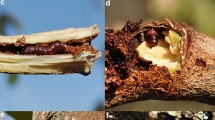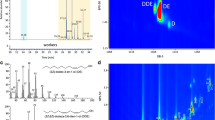Abstract
Subterranean termites of the genus Reticulitermes are known to build walls and tubes and move considerable amounts of soil into wood but the causes of this behavior remain largely unexplored. In laboratory assays, we tested the hypothesis that Reticulitermes virginicus (Banks) would carry more sand into wooden blocks containing corpses compared to corpse-free controls. We further predicted that the corpses of predatory ants would elicit a stronger response than those of a benign beetle species or nestmates. As hypothesized, significantly more sand was carried into blocks containing corpses and this material was typically used to build partitions separating the dead from the rest of the colony. Contrary to expectations, however, this behavior did not vary among corpse types. We then tested the hypothesis that oleic acid, an unsaturated fatty acid released during arthropod decay and used by ants and other arthropod taxa in corpse recognition, would induce a similar building response in R. virginicus. To additionally determine the role of foreign objects in giving rise to this behavior, the experiment was carried out with and without imitation corpses (i.e., small glass beads). As predicted, oleic acid induced building (a tenfold increase) but only when applied to beads, suggesting strong synergism between tactile and chemical cues. Oleic acid also significantly reduced the amount of wood consumed by R. virginicus and may possess useful repellent properties.



Similar content being viewed by others
References
Buczkowski G, Bennett G (2008) Behavioral interactions between Aphaenogaster rudis (Hymenoptera: Formicidae) and Reticulitermes flavipes (Isoptera: Rhinotermitidae): the importance of physical barriers. J Insect Behav 21:296–305
Choe D-H, Millar JG, Rust MK (2009) Chemical signals associated with life inhibit necrophoresis in Argentine ants. PNAS 106:8251–8255
Chouvenc T, Su N-Y (2010) Apparent synergy among defense mechanisms in subterranean termites (Rhinotermitidae) against epizootic events: Limits and potential for biological control. J Econ Entomol 103:1327–1337
Chouvenc T, Su N-Y, Elliott ML (2008) Interaction between the subterranean termite Reticulitermes flavipes (Isoptera: Rhinotermitidae) and the entomopathogenic fungus Metarhizium anisopliae in foraging areas. J Econ Entomol 101:885–893
Chouvenc T, Robert A, Sémon E, Bordereau C (2011) Burial behavior by dealates of the termite Pseudacanthotermes spiniger (Termitidae, Macrotermitinae) induced by chemical signals from termite corpses. Insect Soc. doi:10.1007/s00040-011-0197-3
Cornelius ML, Grace JK (1994) Semiochemicals extracted from a dolichoderine ant affects the feeding and tunneling behavior of the Formosan subterranean termite (Isoptera: Rhinotermitidae). J Econ Entomol 87:705–708
Cremer S, Armitage SAO, Schmid-Hempel P (2007) Social immunity. Curr Biol 17:693–702
Crosland MWJ, Traniello JFA (1997) Behavioral plasticity in division of labor in the lower termite Reticulitermes fukienensis. Naturwissenschaften 84:208–211
Hamilton C, Lay F, Bulmer MS (2011) Subterranean termite prophylactic secretions and external antifungal defenses. J Insect Physiol 57:1259–1266
Hart AG, Ratnieks FLW (2002) Waste management in the leaf-cutting ant Atta colombica. Behav Ecol 13:224–231
Higgins RJ, Lindgren BS (2006) The fine scale physical attributes of coarse woody debris and effects of surrounding stand structure on its utilization by ants (Hymenoptera: Formicidae) in British Columbia, Canada. In: Grove SJ, Hanula JL (eds) Insect biodiversity and dead wood: Proceedings of a symposium for the 22nd International Congress of Entomology. Gen. Tech. Rep. SRS-93. U.S. Department of Agriculture Forest Service, Southern Research Station, pp 67–74
Hölldobler B, Wilson EO (1990) The ants. Harvard University Press, Cambridge
Hostettler NC, Hall DW, Scheffrahn RH (1995) Intracolony morphometric variation and labral shape in Florida Reticulitermes (Isoptera: Rhinotermitidae) soldiers: significance for identification. Fla Entomol 78:119–129
Howse PE (1966) Air movement and termite behavior. Nature 210:967–968
Jones WE, Grace JK, Tamashiro M (1996) Virulence of seven isolates of Beauveria bassiana and Metarhizium anisopliae to Coptotermes formosanus (Isoptera: Rhinotermitidae). Environ Entomol 25:481–487
Kramm KR, West DF, Rockenbach PG (1982) Termite pathogens: transfer of the entomopathogen Metarhizium anisopliae between Reticulitermes sp. termites. J Invertebr Pathol 40:1–6
Li H-F, Su N-Y (2008) Sand displacement during tunnel excavation by the Formosan subterranean termite (Isoptera: Rhinotermitidae). Ann Entomol Soc Am 101:456–462
Li H-F, Yang R-L, Su N-Y (2010) Interspecific competition and territory defense mechanisms of Coptotermes formosanus and Coptotermes gestroi (Isoptera: Rhinotermitidae). Environ Entomol 39:1601–1607
Lyon F, Pizzi A, Imamura Y, Thevenon M-F, Kartal SN, Gril J (2007) Leachability and termite resistance of wood treated with a new preservative: ammonium borate oleate. Holz Roh Werkst 65:359–366
Mburu DM, Ochola L, Maniania NK, Njagi PGN, Gitonga LM, Ndung’u MW, Wanjoya AK, Hassanali A (2009) Relationship between virulence and repellency of entomopathogenic isolates of Metarhizium anisopliae and Beauveria bassiana to the termite Macrotermes michaelseni. J Insect Physiol 55:774–780
Myles TG (2002) Alarm, aggregation, and defense by Reticulitermes flavipes in response to a naturally occurring isolate of Metarhizium anisopliae. Sociobiology 40:243–255
Pearce MJ (1987) Seals, tombs, mummies, and tunneling in the drywood termite Cryptotermes (Isoptera: Kalotermitidae). Sociobiology 13:217–226
Rollo CD, Czyzewska E, Borden JH (1994) Fatty acid necromones for cockroaches. Naturwissenschaften 81:409–410
Rosengaus RB, Traniello JFA, Bulmer MS (2011) Ecology, behavior and evolution of disease resistance in termites. In: Bignell DE, Roisen Y, Lo N (eds) Biology of termites: a modern synthesis. Springer, New York, pp 165–191
Shelton TG, Vogt JT, Appel AG, Oi FM (1999) Observations of Reticulitermes spp. in Solenopsis invicta mounds (Isoptera: Rhinotermitidae, Hymenoptera: Formicidae). Sociobiology 33:265–275
Stuart AM (1967) Alarm, defense, and construction behavior relationships in termites (Isoptera). Science 156:1123–1125
Su N-Y (2005) Response of the Formosan subterranean termites (Isoptera: Rhinotermitidae) to baits or nonrepellent termiticides in extended foraging arenas. J Econ Entomol 98:2143–2152
Visscher PK (1983) The honey bee way of death: necrophoric behavior in Apis mellifera colonies. Anim Behav 31:1070–1076
Wilson EO (1971) The insect societies. Harvard University Press, Cambridge
Wilson EO, Durlach NI, Roth LM (1958) Chemical releasers of necrophoric behavior in ants. Psyche 65:108–114
Wood TG (1988) Termites and the soil environment. Biol Fertil Soils 6:228–236
Yanagawa A, Fujiwara-Tsujii N, Akino T, Yoshimura T, Yanagawa T, Shimizu S (2011) Behavioral changes in the termite, Coptotermes formosanus (Isoptera), inoculated with six fungal isolates. J Invertebr Pathol 107:100–106
Yao M, Rosenfeld J, Attridge S, Sidhu S, Aksenov V, Rollo CD (2009) The ancient chemistry of avoiding risks of predation and disease. Evol Biol 36:267–281
Zoberi MH (1995) Metarhizium anisopliae, a fungal pathogen of Reticulitermes flavipes (Isoptera: Rhinotermitidae). Mycologia 87:354–359
Acknowledgments
We thank Craig Bell and Shawn Cooper for help collecting and counting termites and John Riggins for lending us the necessary traps to collect the bark beetles used in the study. We also thank Brian Forschler, Chris Peterson, Dennis Rowe, and three anonymous reviewers for commenting on an early version of the manuscript.
Author information
Authors and Affiliations
Corresponding author
Additional information
Communicated by: Sven Thatje
Rights and permissions
About this article
Cite this article
Ulyshen, M.D., Shelton, T.G. Evidence of cue synergism in termite corpse response behavior. Naturwissenschaften 99, 89–93 (2012). https://doi.org/10.1007/s00114-011-0871-3
Received:
Revised:
Accepted:
Published:
Issue Date:
DOI: https://doi.org/10.1007/s00114-011-0871-3




